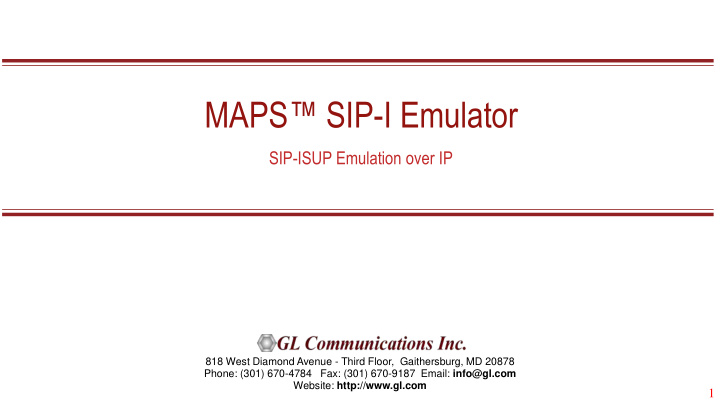



MAPS™ SIP -I Emulator SIP-ISUP Emulation over IP 818 West Diamond Avenue - Third Floor, Gaithersburg, MD 20878 Phone: (301) 670-4784 Fax: (301) 670-9187 Email: info@gl.com Website: http://www.gl.com 1
MAPS™ SIP -I 2
MAPS™ SIP -I 3
Protocol Specific Features Supports both UDP and TCP (Ipv4 and Ipv6). • Generates and processes SIP-I valid and invalid messages. • Each SIP-I message template facilitates customization of the protocol fields and access to the various protocol fields • Signaling from the scripts Handles Retransmissions and Remote Retransmissions. • Supports Call hold, Call redirect, Bind Call Transfer, auto call rejection, and silence packets generation. • Supports transmission and detection of various RTP traffic such as, digits, voice file, Fax, IVR, single tone, and dual • tones in IP networks. Supports Secure Real-time Transport Protocol (or SRTP) traffic initialized over TLS (Transport Layer Security) or • SSL (OpenSSL) Supports both RTP G.711 Pass Through Fax Simulation and T.38 Fax Simulation over UDPTL. • Traffic RTP Voice Traffic Generation used in conjunction with SIP Signaling. • User-defined global statistics for received RTP audio quality metrics are updated periodically on run time • Bulk Video Call Generation supported with H.264 and H.263 video codecs • Supports almost all industry standard codec types • Simulates Signaling Gateway, Softswitch with SIP-I (Profile C) support to test interworking of PSTN services over IP • networks. Applications Fully integrated, complete test environment for SIP-I or SIP-T. • Inter-operability testing of networks • 4
Protocol Specific Standards Available Standards Standard / Specification Used ITU Q.1912.5 - Interworking between Session Initiation Protocol (SIP) and ISDN User Part SIP-I (Profile-C) ND1007:2001/07, PNO-ISC/SPEC/007- Interworking between Session Initiation Protocol (SIP) and UK ISDN User Part (UK ISUP) SIP-T IETF RFC 3372 5
Typical SIP-I Call Procedure 6
Test Scenarios MAPS™ SIP -I simulating UAC and testing MAPS™ SIP -I simulating UAS and testing UAS (DUT) UAC (DUT) 7
RTP Traffic Simulation 8
Secured RTP Traffic Simulation 9
Secured RTP Traffic Simulation 10
SIP-I Testbed Configuration 11
Profile Configuration 12
Incoming Call Handler Configuration 13
Call Generation and Reception 14
Event Log 15
Generating SIP-I Messages 16
Load Generation • Stability/Stress and Performance testing using Load Generation • Different types of Load patterns to distribute load • User can load multiple patterns for selected script • User configurable Test Duration, CPS, Maximum and Minimum Call Rate etc. Ramp Uniform Fixed Normal Step Saw-tooth 17
Customizations - Statistics and Reports MOS, R-Factor Packet Loss Packets Discarded Duplicate Packets Out-Of-Sequence Packets Call Stats provide a running tabular log of system level Jitter Statistics stats, tracked stats include: Total Calls, Active Calls, Completed Calls, Passed Calls, Failed Calls, Instantaneous Calls/Sec 18
Customizations - Call Flow (Scripts) • Scripts are written in our proprietary *.gls scripting language. They represent generic state machines intended provide protocol/signaling logic for a call and establish bearer traffic. • Each instance of a script corresponds to a single transaction/call, i.e if you place 500 calls in parallel you will actually have 500 script instances running at once. If you place 500 calls in series the same script will execute and terminate 500 times. • It is possible to create your own scripts, but almost never necessary! We attempt to provide all necessary scripts out of the box. 19
MAPS™ API Architecture • API wraps our proprietary scripting language in standard languages familiar to the user: ➢ Python ➢ Java ➢ VB Scripts ➢ TCL • Clients and Servers support a “Many -to- Many” relationship, making it very easy for users to develop complex test cases involving multiple signaling protocols. 20
APIs High Level vs Low Level • API is broken into High and Low level function calls / scripts. • For High Level scripts, all the fine-grained protocol control happen in the script running on the MAPS server, hidden from the API user. • Low Level scripts put the API user in complete control of the protocol stack. This makes Low Level scripts more flexible and powerful, but also correspondingly more complex. 21
CLI Support MAPS CLI Server Sample TCL CLI Script 22
23
Recommend
More recommend